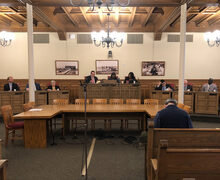While you looked up at the eclipse, SUNY ESF studied animals’ reactions
Alexander Zhiltsov | Staff Photographer
Molly Jacobson is a pollinator ecologist and professor at ESF who is leading the campus’ efforts to contribute to the Eclipse Soundscapes project— a citizen science project funded by the NASA Science Activation program.
Get the latest Syracuse news delivered right to your inbox.
Subscribe to our newsletter here.
As the Syracuse community looked up at last Monday’s once-in-a-lifetime solar eclipse, SUNY ESF students and faculty stared at the ground to observe the responses of animals, birds and insects.
A solar eclipse had not reached full totality in Syracuse since 1925, so scientists studying the behavior of animals and insects at ESF took advantage of this opportunity by sharing their findings with NASA in a project examining how eclipses affect life on Earth.
Molly Jacobson, a pollinator ecologist and professor at ESF, is leading the campus’ efforts to contribute to the Eclipse Soundscapes project— a citizen science project funded by the NASA Science Activation program. This project is modeled after one of the first recorded examples of “eclipse-related participatory science,” led by William M. Wheeler in 1935.
“It’s a way that we can remind ourselves how connected we are to the natural world … so many species all react to the eclipse — just like us — stopping and not knowing what to do,” Jacobson said. “It’s just a great moment to reflect on our place on Earth … to better understand how life on Earth works through seeing how they react to an eclipse is something special.”
During a solar eclipse, the behavior of diurnal and nocturnal species changes due to the alteration of daylight for the period in which the moon covers the sun. Jacobson collaborated with faculty members and student volunteers by using an audio data collector to track irregular movement, noises and interactions between insects, birds and other mammals. They then sent their audio back to NASA through an SD card.
The data collection period ran during the eclipse as well as two days before and after, Jacobson said. The audio collection devices picked up the different bird and insect songs and rustling in the ground, which scientists on NASA’s Soundscapes team will attempt to identify once the citizen scientists send their data.
“Any crickets that were out, maybe at a different time of year, or cicadas, we will see how their activity levels are going to change during the eclipse,” she said.
Along with submitting their data to the project through a form, people who volunteered to participate took visual-auditory sensory notes and pictures of what they witnessed.

Researchers tie audio collectors to trees to track animal behaviors during the eclipse. They will send the data to NASA’s Soundscapes team.
Alexander Zhiltsov | Staff Photographer
Jake Keller, a master’s student at ESF, viewed the eclipse from the Onondaga Lake Parkway and contributed notes to the project. Keller said he wanted to observe the organisms in a less urbanized area of Onondaga County as it gave him the opportunity to take notes on animals from both wet and dry landscapes.
Keller said he could hear the birds gradually stop singing as the eclipse progressed. He also said wetland birds appeared less distracted by the astronomical event than those in other habitats.
“It was definitely quiet, but it wasn’t unsettling at all. It was really beautiful actually,” Keller said. “As soon as full totality ended … everything kind of picked back up. You could kind of feel like a weight — a blanket being lifted — and noise began again.”
After compiling researchers’ contributions to the project worldwide, NASA will post the raw Soundscape information to their Solar Data Analysis Center. For the April 8 eclipse, 2,618 observers signed up to participate, and there were 759 audio data collectors registered in North and South America, according to NASA’s website.
“Citizen science is extremely important and not just a way of collecting a lot of data from a large number of people,” Keller said. “But I think it’s really awesome to get people involved in the natural world and to show them that they can contribute to something really significant.”
Published on April 14, 2024 at 11:03 pm





